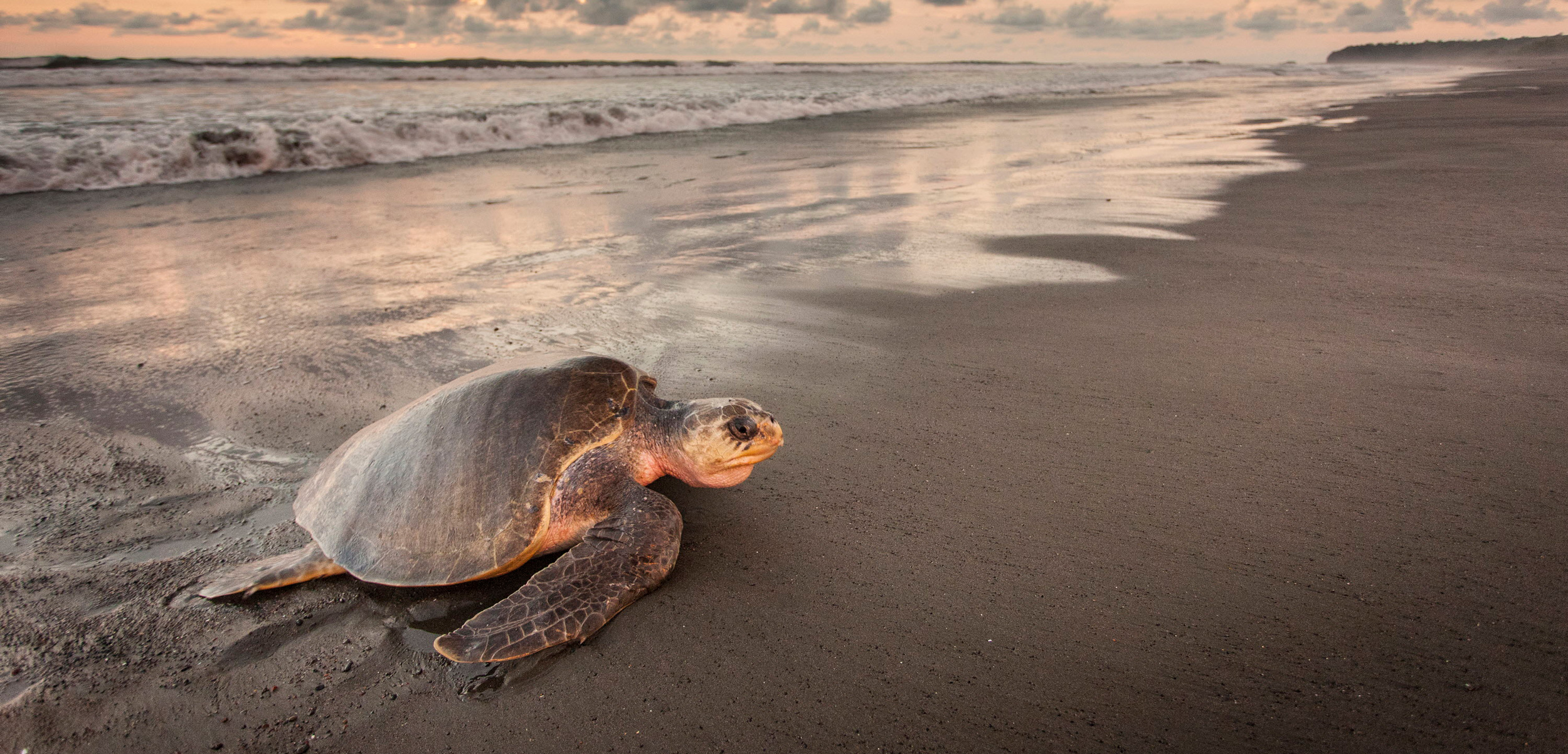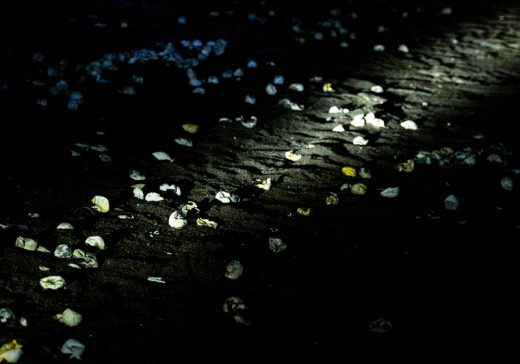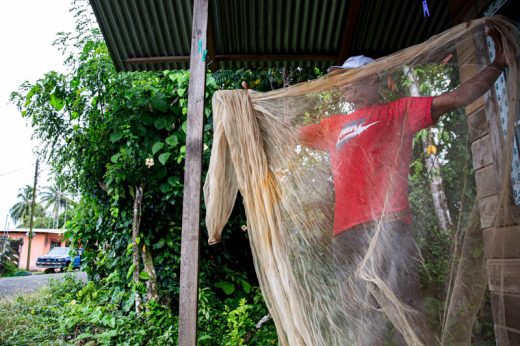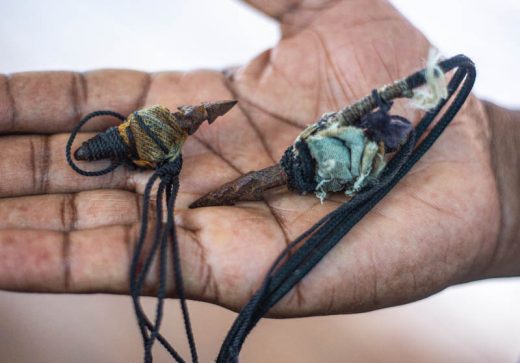The Pandemic Poaching Pandemic
In Costa Rica, Panama, and elsewhere, COVID-19 lockdowns caused suddenly desperate people to begin poaching sea turtle eggs and meat, threatening hard-won conservation achievements.
Article body copy
Miguel Torres spends most of his nights playing a game of cat and mouse. Along with seven colleagues, Torres, a wildlife refuge patrolman, conducts hourly sweeps around Ostional Beach, in northwestern Costa Rica, looking for sea turtle poachers. The key to winning this game, Torres says, is to be as dark as possible. If poachers see you on your phone at the patrol post, they know the coast is clear. If you use your flashlight too much, you give away your position.
Torres only flashes his light when his well-trained eyes see a shadow that’s out of place. That flash is usually enough to send poachers fleeing. And on April 15, 2021, at about midnight, Torres and a colleague came upon three suspicious shadows where the jungle meets the beach. Brandishing his flashlight, he saw two of them bolt into the night. The third shadow remained, squirming in the darkness.
When Torres and his partner got a better look, they froze. It was an olive ridley sea turtle writhing on its back. Its stomach was sliced open, and a trail of eggs led to a hastily abandoned plastic bag and a kitchen knife plunged into the sand.
“We were paralyzed seeing that horror,” Torres says. “We thought they might come back to attack us with machetes, so we called the police.”
Torres filmed the scene to collect evidence while they waited for the police, watching the turtle languish for nearly an hour before it died.
“In all my years of living here,” Torres says. “I’ve never seen anything like that.”
Torres has harvested sea turtle eggs himself. Ostional, the small seaside town where he lives, is home to a rare sustainable sea turtle egg harvest. Each year, thousands of sea turtles flock to the beach protected by the Ostional National Wildlife Refuge during mass nesting events. The community organization Torres patrols for—the name translates to the Ostional Integral Development Association—lets members harvest eggs from the nests during a limited window, and uses income from harvests and tourism to benefit the town and its members. Since the legal harvest began in 1987, Torres has seen the town grow from a few homes with dirt floors and palm-frond roofs to one with restaurants, lodges, and a higher standard of living. But when the COVID-19 pandemic hit and Costa Rica closed its borders, the flow of tourism dollars associated with the wildlife refuge and the legal turtle egg harvest suddenly dried up. Unemployment across the country skyrocketed to more than 24 percent, and rates of poaching climbed with it.
In neighboring Panama, as in Costa Rica, the sudden COVID-19-triggered collapse of the tourism economy caused people to scramble. With empty hotels, deserted restaurants, and tour boats languishing at the docks, many Panamanians looked to the sea to survive.
“All my friends who worked in tourism, everyone I knew, went out to sea to go fish,” says Chencho, a 46-year-old fisherman in Almirante, Panama, who asked to only be identified by his nickname. But in the spring—at the onset of the lockdowns—“the fishing is terrible,” Chencho says. “The currents are too strong—there’s no fish.”
With few fish to fill the spaces between the seats on their tour turned fishing boats, people returned to a practice authorities and NGOs have been trying to curb for decades: hunting sea turtles.
“People are hungry,” Chencho says. Then, letting out a guilty smile, he adds: “And turtles are delicious.”
Hunting sea turtles is something many people still think of fondly. Chencho has his favorite turtle recipe, and remembers when fishermen used to roll carts of turtle meat down the street shouting prices. He still has his custom-made turtle harpoon tips: a longer one to pierce the strong shells of hawksbill sea turtles, and a shorter one to hook green sea turtles. His father whittles special harpoon rods that taper toward the handle and pop off once they pierce a turtle’s shell, letting Chencho haul the turtle alongside his boat using a rope attached to the harpoon tip. Seen as something of a local expert, Chencho says that throughout the pandemic others have approached him to ask how and where to hunt for turtles themselves.
Chencho says that when he catches a turtle, nothing goes to waste except the shell and bones. And while he’ll sell eggs he gathers from a poached turtle, he considers it disrespectful to poach nests. It’s not a reservation shared by everyone.
Cristina Ordoñez, the investigations coordinator at the Sea Turtle Conservancy (STC) in Bocas del Toro, was dismayed when she started noticing more people selling turtle meat in town, and when her beach surveys revealed that the percentage of turtle nests that were being poached had risen from 20 percent to 45 percent throughout 2020.
In the Panamanian Caribbean in the 1960s, Ordoñez says, overconsumption and overcommercialization of turtle meat caused the hawksbill sea turtle population to drop by nearly 98 percent. Since then, education campaigns, strict laws, and stronger enforcement have worked to reverse the declines. There are more hawksbill sea turtles coming to Bocas del Toro to nest every year, Ordoñez says. The open sale of turtle meat stopped in the mid-2000s. “It was like, Why are people going back to this?” says Ordoñez. “But we had to be conscious of what was going on. The pandemic hurt economies in a lot of countries, and we knew that it wasn’t out of malice, but out of necessity.”
In Panama, the strict lockdowns and sealed borders overlapped with turtle nesting season, which can run from March to September. Ordoñez says the government was late to provide financial support to people in the region, and they were forced to find a way to survive.
“So we tried to talk to people to see if they didn’t kill them so brutally, but honestly it was hard,” she says. “If you can’t offer everyone an alternative, you can’t ban something either.”
The poachers who killed the turtle Torres found have since been caught and are awaiting trial. Torres says that while he’s noticed an uptick in poachers from surrounding towns during the pandemic, these specific poachers are repeat offenders who’ve grown more brash over the years. He says things are stabilizing now that tourists are slowly returning, but he wishes they had more support and resources from government authorities so they could detain poachers on the spot.
Tourists are trickling back into Panama as well, and Ordoñez says the sale of turtle meat has dropped after a series of police raids on the homes of people who were selling it. She is hopeful that the situation is improving. But she says the surge in turtle poaching during the pandemic is a reminder that coastal communities need specialized and dedicated support during crises to protect hard-earned conservation goals.
A big part of STC’s work is developing educational campaigns for local and Indigenous communities on the importance of turtle conservation. The NGO provides stipends to encourage people to patrol their own communities and beaches. Ordoñez says the Ngäbe-Buglé Indigenous community, based in Bocas del Toro as well as other parts of northwestern Panama and southern Costa Rica, has become a strong conservation ally, but it’s been a bit tougher to get other Bocatoreños on board. Many see eating turtles as a right and part of their cultural identity.
“The government has to take a bigger initiative [in] figuring out how to help people and prevent them from going back to the beaches to poach,” Ordoñez says. “One thing we learned is that communities are interested in protecting their resources. If they weren’t, our program would have failed.”
But if the community members they were funding to patrol the beaches weren’t being paid, muses Ordoñez, “we don’t know if they would’ve gone back to poaching turtles, too.”
People still drop by Chencho’s house every day during turtle nesting season to ask if he has any turtle meat. They discuss how they’re going to eat that day’s catch, and agree that curry and coconut milk is the key to any good turtle stew.
Chencho says he’d stop poaching turtles if the government gave him a subsidy during turtle nesting season, though he’d prefer a license to hunt one turtle a week. With a good turtle weighing 45 to 90 kilograms, and meat selling at US $5.50 per kilogram, a turtle a week is all he’d need to survive.
“Why do you think God put all these turtles out in the ocean?” Chencho says. “They said that turtles would go extinct, but we ate way more back then. The sea is still filled with turtles, but it’s all the great turtle hunters who’ve disappeared.”





